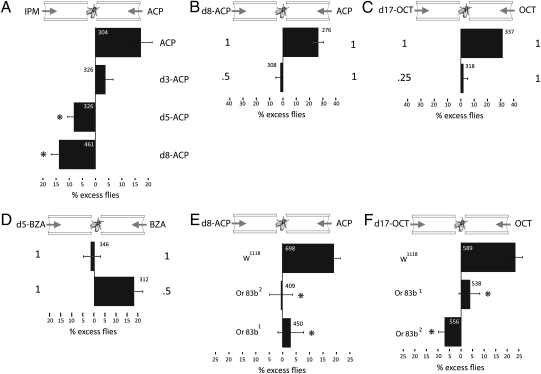Fig. 1.
Differential spontaneous responses to odorants containing deuterium. The mean relative distribution of flies in the arms of the maze (% excess flies) carrying the indicated odorants ± SEM is shown in all graphs. This metric reflects the prevailing distribution within the arms of the maze of groups of 40 to 60 flies tested each time. The total number of flies tested in each group is shown and the number of groups tested is n ≥ 6 for all groups. (A) Spontaneous responses to 75 μL normal or d3-, d5-, or d8-ACP, each diluted with isopropyl myristate (IPM) to 1 mL. Flies spontaneously preferred h-ACP over the solvent. In contrast, incorporation of five or eight deuterium atoms results in significantly different distribution (P < 0.001) from that toward h-ACP (attraction) to aversion. In contrast, the response to d3-ACP was not significantly different (P = 0.012) from that of h-ACP. (B) Flies discriminate against d8-ACP if presented with equal amount (1:1) of h-ACP (75 μL odorant/925 μL IPM). However, a 50% reduction in the amount of deuterated odorant yielded an equal distribution of the flies in the arms (% excess flies not significantly different from zero), defined as a balanced maze. (C) Similarly equal amounts (200 μL) of h-1-octanol (OCT) and d17-1-octanol yielded strong discrimination against the deuterated odorant, which was eliminated upon reducing it by 75% (1:0.25). (D) In contrast, equal amounts of normal and deuterated benzaldehyde (90 μL) did not result in differential discrimination. In accord, decreasing the amount of h-BZA resulted in differential avoidance of d5-BZA. (E) The preferential discrimination against d8-ACP was eliminated in Or83b1 and Or83b2 mutants (P < 0.002 and P < 0.001, respectively, Dunnett test). (F) Similarly, discrimination against d17-octanol was eliminated in Or83b1 and Or83b2 mutants (P < 0.001 for both, Dunnett test).

